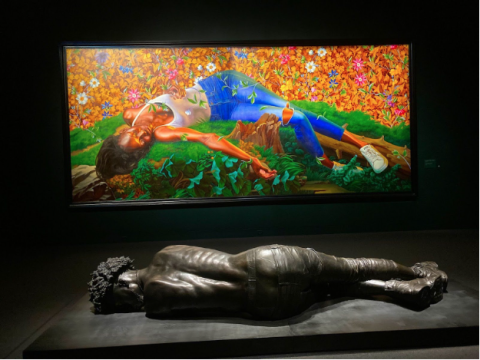Richard Armstrong and Casey Dué
May 8, 2024
After successful runs in Venice, Paris, and San Francisco, Kehinde Wiley’s Archaeology of Silence has been reinstalled in the Museum of Fine Arts Houston, where Classics professors Casey Dué Hackney and Richard Armstrong explored its ensemble of paintings and bronze sculptures. It is a project of scale first and foremost, broken into chapel-like galleries where the brightly-lit pieces dramatically break through darkened spaces, every one featuring the figure of a Black or Brown person in a state of ambiguous repose (most of the models are, in fact, Senegalese, as the project was undertaken during COVID while Wiley remained in Dakar). With names evoking famous classical or neoclassical works like The Dying Gaul, Femme Piquée Par Un Serpent (after Auguste Clésinger’s sculpture) or Young Tarentine (after the work by Alexandre Schoenewerk), each piece transposes the original figure with a contemporary Black one. The following conversation grew from separate viewings and powerful impressions.
RA: I don’t know about you, Casey, but the first thing that hit me is the bold confidence expressed in the sheer scale of this exhibition. Never have I seen a collection of such exquisite paintings next to evocative bronzes that all link to a theme. Normally, one gets that arrangement when works by various artists are housed in a gallery; here you get the same statement repeated in different media, as if to fill an entire museum with Black figures reoccupying classical and neoclassical niches. It feels supremely confident in point of form and execution, but subversive in content. My previous experience with artists working in the public medium of bronze sculpture was when I collaborated with the Art Guys on their Statue of Four Lies at the University of Houston. The whole point there was to desecrate the figural bronze by having their own images cast and set on a plaza inviting students to mess around with them. When they had me assist them with Latin inscriptions, it was to make the work as absurdly formal as possible. At that time, I thought no living artist would be interested in realistic bronze figures, which sit inertly on a public square, ignored by passersby, even if beloved by pigeons. But now here comes Wiley, who has dared to make monumental bronzes that are captivating, showing a use of this medium to full effect and devoid of satire. What was your first impression?
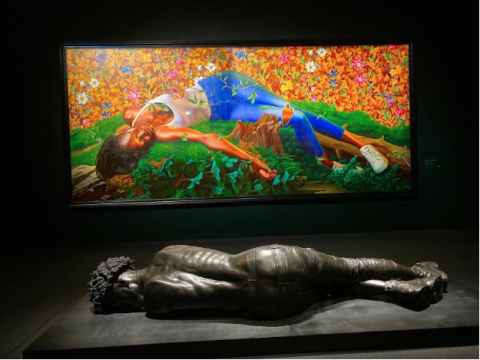
CDH: I was familiar with Wiley’s work and had even seen previous exhibitions of particular paintings at the Museum of Fine Arts Houston (Judith and Holofernes, his presidential portrait of Barack Obama), but I had never experienced it in such a monumental setting before, and with so many pieces, with their repeating themes and interacting with one another, building on one another conceptually. I was certainly impressed by the monumentality of the bronze pieces — the same week that I saw the exhibition I had been teaching my students about how ancient Greek bronze sculptures were made. But my work on ancient Greek songs of lament and the botanical similes of the Iliad drew me instinctively to the painted portraits, which are themselves monumental — we might say epic — in size. One of my favorite Wiley paintings, which I have never seen in person, is Portrait of Tarek Ali Ellis and Michael Morgan (2023, not part of this show), showing two young Black men in a pietà-like composition. Their blue and brown colored clothing blends with flowers of gold, deep red, and white, together with roots and leaves of blue. When I look at that portrait I see not Mary and Jesus but Achilles and Patroklos, though I can’t claim that was Wiley’s intention. This merging of sculpted and painted subjects, mother and child and contemporary young Black men, maternal grief and care and a hyper-masculine grief and care that defies categorization, captures for me the intensity of the emotional bond between Achilles and Patroklos in the Iliad, which is often expressed in similes that compare them to parent and child. Mary Ebbott and I have written about this kind of bond between soldiers in a piece we called “Mothers-in Arms.”
RA: But Archaeology of Silence does work from both classical and neoclassical models directly. One vivid case in point is his bronze Dying Gaul, which takes the pose of the famous Roman copy of what may have been a Hellenistic bronze but features a contemporary figure. While the ancient work features a naked male warrior, identifiable as a Celt from his neck torque, spiked hair and mustache, and perhaps even his heroic nudity, Wiley’s figure is not only completely clothed, but wearing a hoodie that obscures the face almost completely . Instead of the raw expression of dying anguish we see in the Celtic warrior, with Wiley’s work we have the almost anonymous pain of a man clothed in the universal casual wear found around the world. This seems an important point in all of these works: unlike many of his neoclassical and classical models, Wiley depicts all of his subjects as clothed, save a few pieces featuring men with their shirts off. Though many are modeled on dying or dead figures, like Femme Piquée Par Un Serpent (a nude young woman bitten by a snake) or the Young Tarentine (a nude figure of a drowned woman), the repose of Wiley’s series is ambiguous, between death and sleep. While it grew in part from protests over murdered Black people, Wiley’s project is not just to present us with the body count, nor is it edgy trauma porn. There is something more ambivalent here, resting on the ambiguities of aesthetic form. And in this regard, we might well consider it a definitive study in Black classicism. It is as if he has fully absorbed the classical figural tradition and its reception and imitation since the Renaissance with its penchant for ideality, allegory, and sensuality (why are so many abstract figures of Justice or Peace bare-breasted women?), and turned it back filled with Black subjects monumentalized as everymen and -women, clothed in a dignity that resists the tawdry objectification one sees in so much nineteenth-century neoclassical art. Compared to Wiley’s versions, Clésinger’s and Schoenewerk’s sculptures look like fancy soft porn.
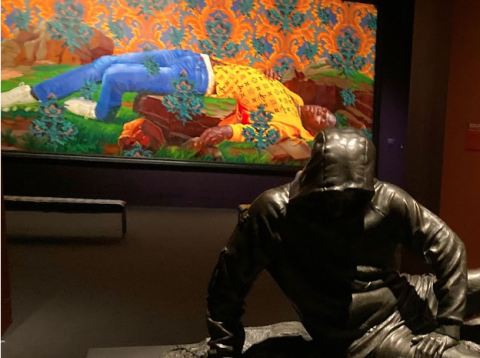
CDH: Again, I can’t help but return to the Iliad, where the deaths of young men, both Greek and Trojan, are narrated in shockingly vivid detail and, at the same time, they are made beautiful in death. They are mourned, sometimes in first person, but more often with botanical imagery that evokes the ancient Greek lament tradition, songs of grief that pervade Homeric epic. These laments, images, and similes drawn from the natural world of Homeric epic highlight the mortality of the hero and the death of warriors at the peak of their youth and beauty, even as this poetry celebrates death in battle as the most glorious way to die. The death of Gorgythion at Iliad 8.302–308 is one particularly beautiful example of this kind of passage, for which I cite the evocative translation of Samuel Butler, only slightly adapted:
Faultless Gorgythion,
Priam’s brave son, the arrow hit, in the chest.
Him his mother bore after she had been married from Aisyme,
fair Kastianeira, lovely as a goddess.
And now he bowed his head as a garden poppy
in full bloom when it is weighed down by showers in spring—
even thus heavy bowed his head beneath the weight of his helmet.
Members of ancient audiences of the Iliad could have easily imagined these words in a lament sung in the first person by Kastianeira upon learning of the death of her son in battle. Achilles is mourned throughout the Iliad though his death is only foretold and occurs outside the confines of the Iliad. In book 9 of the poem, Achilles contrasts two possibilities for his life story (9.410-416, trans. Casey Dué Hackney):
My mother the goddess Thetis of the shining feet tells me that there are two ways in which I may meet my end. If I stay here and fight around the city of Troy, my homecoming is lost, but my glory in song [kleos] will be unwilting: whereas if I reach home my kleos is lost, but my life will be long, and the outcome of death will not soon take me.
There is an implied metaphor here. Achilles is the mortal hero who will bloom and wither all too quickly, but the song of glory that lives on after him will be a flower that never wilts. What I love about Wiley’s paintings is that they play on this same metaphor. The painted flowers of his portraits turn his subjects into timeless figures who are forever in bloom, who will never wilt.
The young men and women depicted in An Archaeology of Silence transcend time via the permanence of art, but they are not generic. Whereas earlier instantiations of such themes as Femme Piquée Par Un Serpent do not incorporate the names of their models into their titles, those displayed in An Archaeology of Silence are named figures, grounded in an historical moment. Evoking as they do the tragic deaths of George Floyd, Breonna Taylor, and so many others, we are called to see them as individuals even as we recognize the devastating pattern of their stories. At the Houston march in protest of the killing of Houston native George Floyd in June 2020, organizers shouted to the crowd to say their names. And we did.
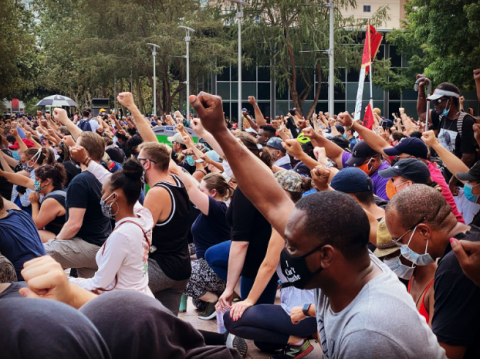
So too do the similes and laments of the Iliad draw on the imagery, language, themes, and narrative structures of the oral tradition within which they were composed to make generic associations that transcend time, while at the same time they grieve and memorialize the deaths of warriors as individual characters. In the video that accompanies the exhibit on the Museum of Fine Arts Houston website, Wiley talks about how portraiture can do this: “It’s a mirror into how we can live forever. Portraiture allows us to live for a very long time.”

RA: I think this is why people interested in classical culture really need to see this exhibition and respond. The Washington Post art critic Sebastian Smee reviewed the San Francisco version of this exhibition and dismissed Wiley’s art as kitsch, which struck me as remarkably off the mark. But the more I thought about it, the more I realized Wiley’s work, in a sense, is the redemption of kitsch--by which I mean he takes over works that use classicism as a facile formula to excuse an interest in the human form (again, often naked women) by some element of pathos (a snake bite, death at sea just before the wedding), and he reoccupies them with Black figures that are modeled on real, named people, fully clothed and participating in the representation. Or take the more notorious kitsch of classicism used to justify domination, as in the neoclassical paintings of Napoleon I (cf. Wiley’s Napoleon Leading the Army over the Alps in the Brooklyn Museum) or in Neo-Confederate memorials, like the J.E.B. Stuart equestrian statue, whose horse is explicitly copied in Wiley’s massive Archaeology of Silence, which is the towering work at the center of the exhibition in Houston. In place of the Confederate general, Wiley places the limp figure of a Black man draped over the horse, whose reins hang down to the base of the pedestal. The Lost Cause sentimentality that was invested in the statues of Monument Avenue in Richmond is negated and transformed in Wiley’s work, which uses a Black body to remind us both of the real cause of the Civil War and the violence done to Black bodies that is being whitewashed by raising heroic Confederate memorials. That is the “silence” he is explicitly excavating in this work. I also find it symptomatic when Smee or Jessica Dawson remark on the current of homoeroticism in Wiley’s figural art. Their pearl-clutching comments again reveal their complicity in the assumption that heteronormative eroticism, which infuses many of the works Wiley riffs on, doesn’t need questioning itself — here’s yet another silence to be excavated. Black bodies have long been the cynosure of American attention as athletes, as victims of lynching and violence, as entertainers. This project monumentalizes them as subjects of art, something long overdue; and the repetition of these figural motifs throughout the exhibition feels positively epic.
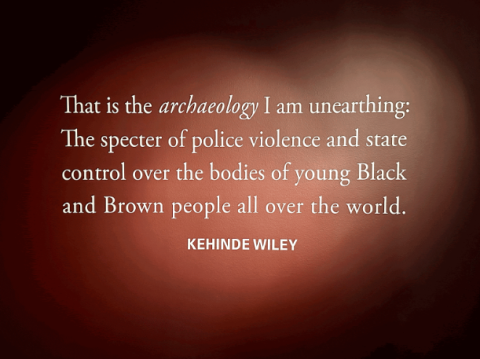
Authors
